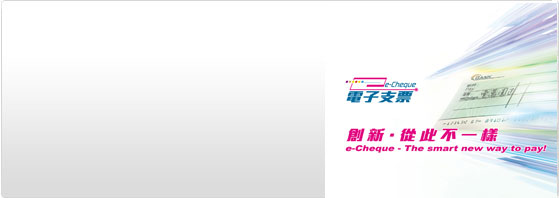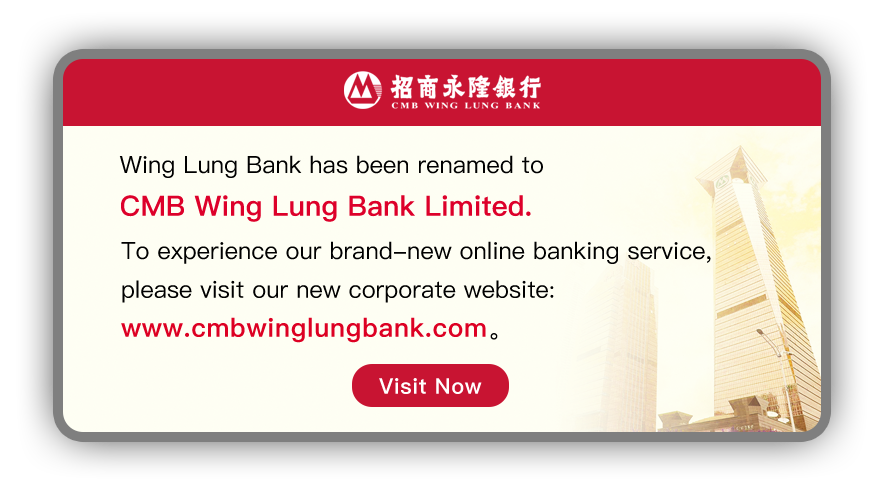e-Cheque Service
- e-Cheque Service

CMB Wing Lung Bank (“the Bank”) newly launches e-Cheque Services.
Frequently Asked Questions
- 1.
- What are the reasons for the HKMA and the banking industry to develop e-Cheque? Is it their intention to replace paper cheque?
The objective for the HKMA and the banking industry to develop e-Cheque is to offer
the public with an additional safe and efficient payment instrument to suit their
varying needs of payment services.
The banks will continue to offer paper
cheque to their customers as a basic banking service.
- 2.
- What is e-Cheque service?
e-Cheque is a Portable Document Format (PDF) document and has a similar image layout as paper cheque which shows all essential information including cheque date, payee’s name and cheque amount. The payer may issue an e-Cheque via the Internet banking platform and send the e-Cheque to the payee’s email address. Once receipt of the e-Cheque, the payee may deposit the e-Cheque to his bank account via the Internet banking platform or the e-Cheque Drop Box provided by the HKICL. The e-Cheque Drop Box can be accessed through the website http://www.echeque.hkicl.com.hk or mobile application.
- 3.
- What are the benefits for the banks to adopt e-Cheque?
The automated processing of e-Cheques obviates many of the cumbersome procedures and saves the cost for the banks to process paper cheques. It also allows the banks to offer an additional safe and efficient payment service to their customers.
- 4.
- What will drive the public to use e-Cheques rather than other forms of transfer (e.g. electronic fund transfer)?
Both the payer and the payee enjoy adequate legal protection as e-Cheques are governed
by the Bills of Exchange Ordinance. Besides, unlike certain electronic payment or
funds transfer service, the payee does not need to disclose the bank account number
to the payer in order to receive an e-Cheque payment.
The payee also has
the flexibility to determine which bank account to deposit the e-Cheque after receiving
it.
- 5.
- What are the security measures of e-Cheque?
First, every e-Cheque is digitally signed using the Public Key Infrastructure (PKI) technology. Any attempt to alter any information shown on the e-Cheque will render the digital signature invalid and thus the e-Cheque not presentable. Second, the virtual e-Cheque book is kept by the paying banks, thus eliminating the chance of any unauthorized access of the physical cheque book. Third, the e-Cheque issuance record kept by the paying bank provides an additional channel for the bank to verify the e-Cheques.
- 6.
- Will the online deposit of the e-Cheques be affected if the e-Cheque Drop Box provided by the HKICL is intruded by the hackers?
The e-Cheque Drop Box is equipped with adequate security and resilience measures to guard against cyber attacks.
- 7.
- As e-Cheques can be delivered through the emails and the security level of the emails is generally low, are there any measures to guard against email fraud cases? How can the banks verify the genuineness of the e-Cheques?
Bank customers should deliver the e-Cheques in a secured way, for instance, by
using the email systems with better security measures or encrypting the e-Cheques
before delivery. We will conduct consumer education campaign to educate the public
to use e-Cheques in a smart way.
Besides, the banks can easily verify the
genuineness of e-Cheques by the digital signatures embedded therein.
- 8.
- Which party, bank or customer, will be responsible for the loss if there are fraud cases?
The banks will make reference to the prevailing practices in relation to handling paper cheque fraud cases when encountering e-Cheque fraud cases.
- 9.
- Some contactless credit cards issued by the banks have stored the cardholder names therein which could be accessed by some unauthorized parties under certain circumstances. Are e-Cheques exposed to similar risk of data leakage? Are there any measures to guard against unauthorized access of the e-Cheque information? What is the surveillance work in place?
Similar to paper cheques, e-Cheques contain minimal sensitive information and do not require the payees to disclose the bank account numbers to the payers. We will conduct consumer education campaign to remind the public to use a secured channel (e.g. secured email system) and encrypt an e-Cheque (e.g. password protected) where necessary before delivery.
- 10.
- For some clients, something physical (i.e. paper cheque) provides a sense of security. How would you respond to their concern?
e-Cheques carry more stringent security features than paper cheques (please refer to A5 for details). Nonetheless, bank customers can continue to use paper cheques according to their needs and preference as the banks will continue to offer paper cheques as a basic banking service.
- 11.
- What is a digital certificate? Why do I need a digital certificate for issuing e-Cheques?
A digital certificate is a form of electronic record which serves as a guaranty of identity who claims to be in conducting electronic transactions. It contains information that can identify the certification authority issuing it, the person to whom it is issued, and keys of the person to whom it is issued. The payer should use the digital certificate issued by one of the recognized certification authorities to digitally sign the e-Cheques, which substitutes the hand-written signature on a paper cheque. Some paying banks may offer a one-stop service to apply, renew and keep custody of the digital certificates on behalf of the payers to facilitate the latter to digitally sign the e-Cheques. Please contact your banks for details.
- 12.
- If customers do not have any Internet banking account, how can they use the e-Cheque service?
It is essential for the customers to have Internet banking accounts to issue e-Cheques. On the other hand, they can deposit the e-Cheques through the e-Cheque Drop Box provided by the HKICL regardless of whether they have Internet banking accounts or not.
- 13.
- If the payees do not have any email accounts, how can they receive e-Cheques? Can they receive e-Cheques through other electronic means, such as WeChat or WhatsApp? Can they decline the receipt of e-Cheques?
If the payees do not have any email accounts, they can still receive e-Cheques through other electronic means such as the online communication tools. Besides, both the payer and payee should agree on the choice of payment instrument. The payee can ask the payer to use other payment means if he/she does not prefer to use e-Cheque.
- 14.
- How will you assist the elderly who are not used to the Internet banking services in using e-Cheques?
The bank customers can ask other trusted persons (e.g. family members) to deposit
the e-Cheques to the designated bank accounts on their behalf. They can also seek
assistance from the banks.
Besides, both the payer and payee should agree
on the choice of payment instrument. The payee can ask the payer to use other payment
means if he/she does not prefer to use e-Cheques.
- 15.
- When will the e-Cheques be settled after they are deposited online?
e-Cheques deposited before the cut-off times via the Internet banking platform
or the e-Cheque Drop Box will be settled in the afternoon of the next business day
(from Monday to Friday except public holidays) under normal circumstances.
The cut-off time for the e-Cheque deposit via the e-Cheque Drop Box is 5:30pm (from
Monday to Friday except public holidays).
The cut-off time for the e-Cheque
deposit via our Internet banking platforms should be 5:30pm (from Monday to Friday
except public holidays).
- 16.
- What is the exact time for me to receive the e-Cheque payment? What should I do if I could not receive the funds before the specific time?
Similar to the arrangements for the paper cheque, the times for the individual collecting banks to make the funds available to the payees may vary. The customers should enquire the banks concerned for details.
- 17.
- How can the customers know the status of the deposited e-Cheques?
Customers may check the status of the deposited e-Cheques via the “Transaction History” of the Internet banking platforms of the collecting banks. For the customers who deposit the e-Cheques via the e-Cheque Drop Box, they may visit the website or mobile application of the e-Cheque Drop Box for the status of the deposited e-Cheques.
We will continue to provide you with more high-quality and convenient services. Please keep a close eye on CMB Wing Lung WeChat Banking Services!
Customer Services Hotline:
(Hong Kong) 230 95555 /
(Mainland) 4008 822388










